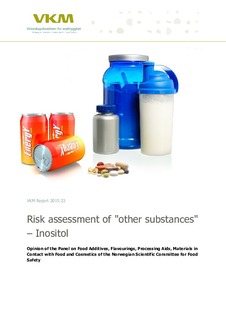| dc.contributor.author | Rohloff, Jens | |
| dc.contributor.author | Bruzell, Ellen Merete | |
| dc.contributor.author | Granum, Berit | |
| dc.contributor.author | Hetland, Ragna Bogen | |
| dc.contributor.author | Husøy, Trine | |
| dc.contributor.author | Wicklund, Trude | |
| dc.contributor.author | Steffensen, Inger-Lise | |
| dc.date.accessioned | 2017-10-20T06:08:35Z | |
| dc.date.available | 2017-10-20T06:08:35Z | |
| dc.date.created | 2017-10-19T13:03:53Z | |
| dc.date.issued | 2015 | |
| dc.identifier.isbn | 978-82-8259-178-2 | |
| dc.identifier.uri | http://hdl.handle.net/11250/2461126 | |
| dc.description.abstract | The Norwegian Scientific Committee for Food Safety (VKM) has, at the request of the Norwegian Food Safety Authority, assessed the risk of intake of 10 mg inositol per 100 ml energy drink. Inositol occurs naturally in all organisms including humans and is present in food. Among the nine possible stereoisomers of inositol, myo-inositol is the most abundant. Myo-inositol is naturally occurring in the body and is present in various types of food.
The human study with the longest exposure at highest doses (3 months treatment at maximum tolerated dose) that was available for risk assessment was a clinical study of 40-74 year old smokers with bronchial dysplasia, from which a NOAEL of 18 g/day of myo-inositol was established (Lam et al., 2006). For all age groups, the MOE values estimated from this study were in the range of 857 to 2570 for mean chronic intake and in the range of 367 to 857 for high chronic intake of energy drinks, respectively, i.e. far above the acceptable MOE value of 30.
In addition, for the high acute drinking pattern and for the mean chronic and the high chronic drinking patterns all estimated intakes of inositol from energy drinks containing 10 mg/100 ml were far below the endogenous production (57 mg/kg bw per day), and also below the dietary intake (7-14 mg/kg bw per day).
VKM concludes that it is unlikely that the exposure to inositol from the high acute, the mean chronic and the high chronic drinking patterns causes adverse health effects in children (3 to < 10 years and 10 to < 14 years), adolescents (14 to < 18 years) and adults (≥18 years). | nb_NO |
| dc.language.iso | eng | nb_NO |
| dc.publisher | Norwegian Scientific Committee for Food Safety (VKM) | nb_NO |
| dc.relation.ispartof | VKM Report | |
| dc.relation.ispartofseries | VKM Report; | |
| dc.relation.uri | https://vkm.no/download/18.645b840415d03a2fe8f260ae/1502803918452/1a9e1c19f7.pdf | |
| dc.title | Risk assessment of "other substances" – Inositol. Opinion of the Panel on Food Additives, Flavourings, Processing Aids, Materials in Contact with Food and Cosmetics of the Norwegian Scientific Committee for Food Safety | nb_NO |
| dc.type | Research report | nb_NO |
| dc.description.version | publishedVersion | nb_NO |
| dc.source.pagenumber | 40 | nb_NO |
| dc.source.issue | 2015:23 | nb_NO |
| dc.identifier.cristin | 1505924 | |
| cristin.unitcode | 194,66,10,0 | |
| cristin.unitname | Institutt for biologi | |
| cristin.ispublished | true | |
| cristin.fulltext | original | |
